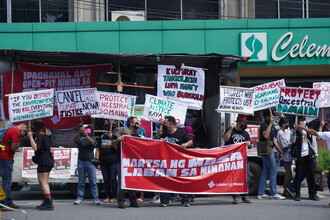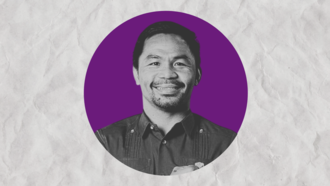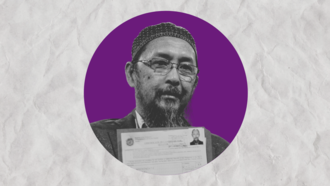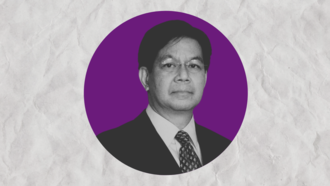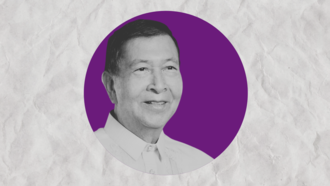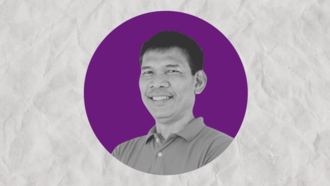-
Uphold the Ban! Protect Tampakan!We strongly condemn the railroading of the amendment of the Environment Code of South Cotabato, specifically the lifting of the ban on Open-Pit Mining. The Sangguniang Panlalawigan of South Cotabato did not consider the magnitude of the effects their actions have on the people and the environment, not only in South Cotabato. With this action alone, it will affect multiple watersheds of South Cotabato, Sultan Kudarat, Maguindanao and Davao del Sur. Further, it will also threaten the ecological integrities of Allah Valley (102,000 hectares) in Sultan Kudarat, the watershed of the Padada River (120,000 hectares) in Davao del Sur, and the watershed of the Marbel River (122,000 hectares) in the Province of Cotabato. Watersheds are geographical ecological units, and what happens in one part of the watershed will influence the whole watershed from forests, agricultural, urban, and coastal to estuarine ecosystems due to its geomorphological characteristics, connected rivers and tributaries at the surface, and including groundwater reserves. Open-Pit or Strip Mining is a metallic mining method assessed as one of the most extensively difficult to mitigate and manage; its impacts do not focus on one contained area. It also requires mass deforestation and removing 20-30 meters of the laterite zone to access the metallic resources underneath. This large-scale industry demands enormous hectares of land for operational processes from stripping, extraction, and tailings treatment, to ship loading and refinery. Furthermore, the Tampakan Open-Pit Mining will demand and use groundwater resources and transport highly toxic wastewater through a 150-km pipe from the Municipality of Malalag draining to Davao Gulf. There is a treatment process presented, however, the risks of overland flow, flooding disasters, or possible collapse of tailings ponds will inevitably impair marine and aquatic biodiversity, fish stocks, and aquaculture in the coastal areas, similar to the incident in Mapagba River in Banaybanay last January 2022. The Open-Pit Mining in Tampakan will hugely affect the long-term viability and sustainability of these watersheds that currently provide ecological services and natural resources to the people of South-Central Mindanao. The Tampakan Open-Pit Mining will become the largest mining in Southeast Asia. According to the project information, it is estimated to extract 2.94 billion tons of metallic resources, 15 million tons of copper, and 17.6 million ounces of Gold. According to S&P Global Market, Open-Pit mining emits a vast amount of greenhouse gases than underground mining methods. On average, copper mining emits 2.3-2.5 tons of Carbon Dioxide (CO2) per ton of metal and nearly 1 ton of CO2 emitted per ounce of gold produced. Combining both Copper and Gold extractions, it is estimated that around 55 million tons of CO2 will be added to the country’s greenhouse gas contribution. Hence, this is ironic to our country’s commitment during the United Nations Climate Change Conference (COP26) in Glasgow that said it is moving ahead with urgency in cutting greenhouse gas emissions and committed to reducing its emissions by 75% in 2030.620 of 800 SignaturesCreated by Interfacing Development Interventions for Sustainability Inc.

-
PETITION TO SHUT DOWN ABUSIVE ONLINE LENDING APPSThis is crucial because numerous lives have been harmed and wasted as a result of Online Lending Applications (OLA). We seek justice for all victims, particularly those experiencing depression and contemplating ending their lives due to the extreme distress caused by the humiliation and intimidation from these OLAs. Many victims have lost their jobs because OLA agents have sent malicious messages to their bosses, tarnishing their reputations. Some are contemplating suicide due to trauma and depression caused by death threats, social media slander, and communication with friends and colleagues. These individuals can no longer return to their normal lives, experiencing broken relationships and friendships—all because of debts they did not intend to evade. Instead, they sought a delay in payment, only to face intimidation, threats, and humiliation on social media, affecting their friends and relatives.43,751 of 45,000 SignaturesCreated by Vanessa Burdeos

-
Spendcash (SpendCash Lending Inc.)We have been receiving unfair debt collection practices such as insults and use of profane language,violent threats,fals representation,publication of our names in social media, invasion of our data privacy,calling and threatening our personal contacts/friends/ family and relatives which greatly put us to very shameful situation. We hope u will help us take this matter urgently. More Power.God bless Location: Quezon City564 of 600 SignaturesCreated by Ricky Pecimo
-
Dear Presidential Candidate: Vice President Leni RobredoCurrent and dominant election narratives in the news and in social media focus on personalities and partisanship. We believe that this focus must be shifted and more space must be made for tackling issues, particularly the issues that will define the future of the planet and the fate of the youth. The #Love52 movement envisions an empowered and forceful youth voice that is demanding good governance and a better normal. “Why do we vote?” We vote to protect our loved ones, our country, and our planet. Together with various youth nationwide, we’ll seed changes in the Filipinos’ thinking about election issues, and show them that they have the power to change the narrative and move candidates to adopt the youth agenda.167 of 200 SignaturesCreated by Love, 52

-
Dear Presidential Candidate: Senator Manny PacquiaoCurrent and dominant election narratives in the news and in social media focus on personalities and partisanship. We believe that this focus must be shifted and more space must be made for tackling issues, particularly the issues that will define the future of the planet and the fate of the youth. The #Love52 movement envisions an empowered and forceful youth voice that is demanding good governance and a better normal. “Why do we vote?” We vote to protect our loved ones, our country, and our planet. Together with various youth nationwide, we’ll seed changes in the Filipinos’ thinking about election issues, and show them that they have the power to change the narrative and move candidates to adopt the youth agenda.9 of 100 SignaturesCreated by Love, 52

-
Dear Presidential Candidate: Dr. & Atty. Joey MontemayorCurrent and dominant election narratives in the news and in social media focus on personalities and partisanship. We believe that this focus must be shifted and more space must be made for tackling issues, particularly the issues that will define the future of the planet and the fate of the youth. The #Love52 movement envisions an empowered and forceful youth voice that is demanding good governance and a better normal. “Why do we vote?” We vote to protect our loved ones, our country, and our planet. Together with various youth nationwide, we’ll seed changes in the Filipinos’ thinking about election issues, and show them that they have the power to change the narrative and move candidates to adopt the youth agenda.10 of 100 SignaturesCreated by Love, 52

-
Dear Presidential Candidate: Mr. Bongbong MarcosCurrent and dominant election narratives in the news and in social media focus on personalities and partisanship. We believe that this focus must be shifted and more space must be made for tackling issues, particularly the issues that will define the future of the planet and the fate of the youth. The #Love52 movement envisions an empowered and forceful youth voice that is demanding good governance and a better normal. “Why do we vote?” We vote to protect our loved ones, our country, and our planet. Together with various youth nationwide, we’ll seed changes in the Filipinos’ thinking about election issues, and show them that they have the power to change the narrative and move candidates to adopt the youth agenda.50 of 100 SignaturesCreated by Love, 52

-
Dear Presidential Candidate: Mr. Faisal MangondatoCurrent and dominant election narratives in the news and in social media focus on personalities and partisanship. We believe that this focus must be shifted and more space must be made for tackling issues, particularly the issues that will define the future of the planet and the fate of the youth. The #Love52 movement envisions an empowered and forceful youth voice that is demanding good governance and a better normal. “Why do we vote?” We vote to protect our loved ones, our country, and our planet. Together with various youth nationwide, we’ll seed changes in the Filipinos’ thinking about election issues, and show them that they have the power to change the narrative and move candidates to adopt the youth agenda.9 of 100 SignaturesCreated by Love, 52

-
Dear Presidential Candidate: Senator Ping LacsonCurrent and dominant election narratives in the news and in social media focus on personalities and partisanship. We believe that this focus must be shifted and more space must be made for tackling issues, particularly the issues that will define the future of the planet and the fate of the youth. The #Love52 movement envisions an empowered and forceful youth voice that is demanding good governance and a better normal. “Why do we vote?” We vote to protect our loved ones, our country, and our planet. Together with various youth nationwide, we’ll seed changes in the Filipinos’ thinking about election issues, and show them that they have the power to change the narrative and move candidates to adopt the youth agenda.10 of 100 SignaturesCreated by Love, 52

-
Dear Presidential Candidate: Mr. Norberto GonzalesCurrent and dominant election narratives in the news and in social media focus on personalities and partisanship. We believe that this focus must be shifted and more space must be made for tackling issues, particularly the issues that will define the future of the planet and the fate of the youth. The #Love52 movement envisions an empowered and forceful youth voice that is demanding good governance and a better normal. “Why do we vote?” We vote to protect our loved ones, our country, and our planet. Together with various youth nationwide, we’ll seed changes in the Filipinos’ thinking about election issues, and show them that they have the power to change the narrative and move candidates to adopt the youth agenda.7 of 100 SignaturesCreated by Love, 52

-
Dear Presidential Candidate: Mayor Isko MorenoCurrent and dominant election narratives in the news and in social media focus on personalities and partisanship. We believe that this focus must be shifted and more space must be made for tackling issues, particularly the issues that will define the future of the planet and the fate of the youth. The #Love52 movement envisions an empowered and forceful youth voice that is demanding good governance and a better normal. “Why do we vote?” We vote to protect our loved ones, our country, and our planet. Together with various youth nationwide, we’ll seed changes in the Filipinos’ thinking about election issues, and show them that they have the power to change the narrative and move candidates to adopt the youth agenda.12 of 100 SignaturesCreated by Love, 52

-
Dear Presidential Candidate: Mr. Leody de GuzmanCurrent and dominant election narratives in the news and in social media focus on personalities and partisanship. We believe that this focus must be shifted and more space must be made for tackling issues, particularly the issues that will define the future of the planet and the fate of the youth. The #Love52 movement envisions an empowered and forceful youth voice that is demanding good governance and a better normal. “Why do we vote?” We vote to protect our loved ones, our country, and our planet. Together with various youth nationwide, we’ll seed changes in the Filipinos’ thinking about election issues, and show them that they have the power to change the narrative and move candidates to adopt the youth agenda.11 of 100 SignaturesCreated by Love, 52


